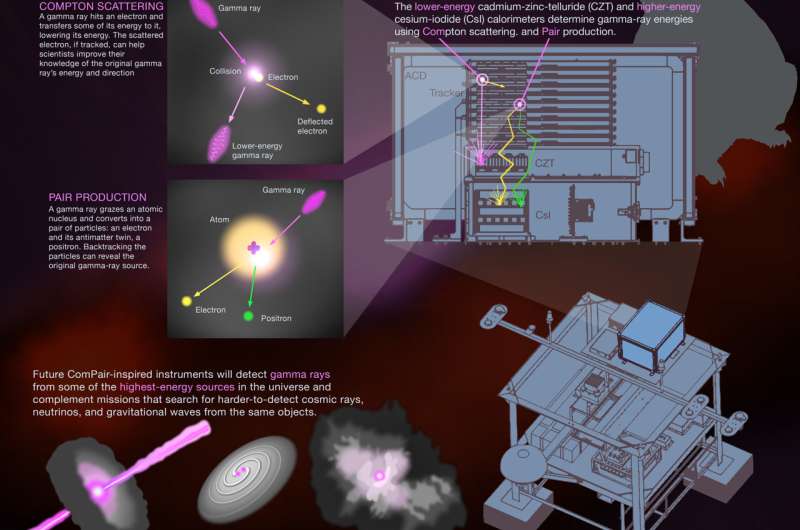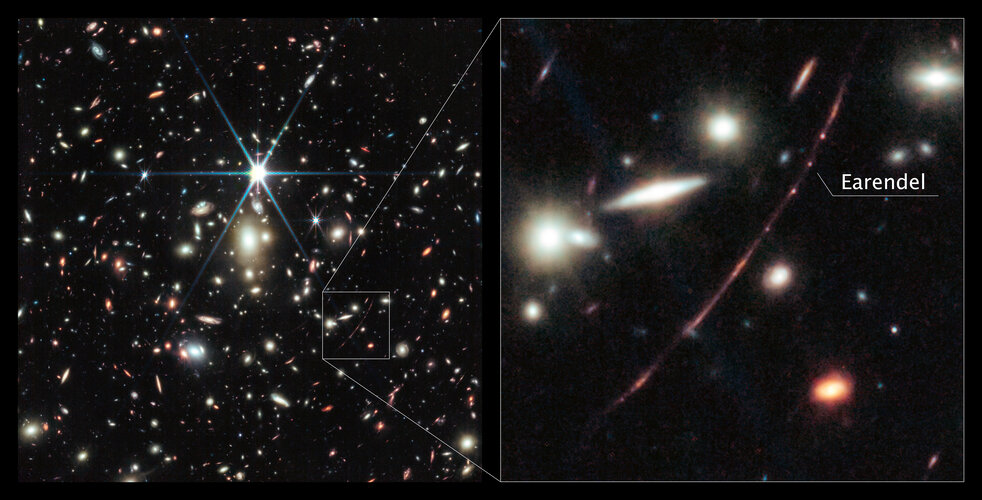
Copernical Team
NASA's ComPair balloon mission readies for flight

A team in Fort Sumner, New Mexico, is preparing to fly a balloon-borne science instrument called ComPair, which will test new technologies for detecting gamma rays, the highest-energy form of light.
ComPair is slated to fly early in NASA's 2023 fall scientific balloon campaign, which opens on Thursday, Aug. 10, weather permitting.
"Lots of interesting science happens in the energy range that ComPair is designed to study," said Nicholas Kirschner, a graduate student at George Washington University in Washington and NASA's Goddard Space Flight Center in Greenbelt, Maryland, who works on the mission. "These gamma rays are hard to capture with existing methods, so we need to create and test new ones. ComPair's flight gets us one step closer to putting a similar detector in space."
ComPair detects gamma rays with energies between 200,000 and 20 million electron volts. Visible light's energy falls between 2 and 3 electron volts, for comparison.
Supernovae and powerful explosions called gamma-ray bursts shine the brightest in this energy range.
Earendel and the Sunrise Arc in the galaxy cluster WHL0137-08
 Image:
Image:
This image from the NASA/ESA/CSA James Webb Space Telescope shows a massive galaxy cluster called WHL0137-08, and at the right, an inset of the most strongly magnified galaxy known in the Universe’s first billion years: the Sunrise Arc. Within that galaxy is the most distant star ever detected, first discovered by the NASA/ESA Hubble Space Telescope.
Webb’s NIRCam (Near-Infrared Camera) instrument reveals the star, nicknamed Earendel, to be a massive B-type star more than twice as hot as our Sun, and about a million times more luminous. Stars of this mass often have companions. Astronomers did not
Ariane 6 joint update report, 9 August 2023

Here is the latest regular report on progress made and upcoming steps towards inaugural flight of the new Ariane 6 launcher.
The next update will be detailed at a media briefing to be held in September.
Deep Space communications to get a laser boost
 Set to launch this fall, NASA's Deep Space Optical Communications (DSOC) project will test how lasers could speed up data transmission far beyond the capacity of current radio frequency systems used in space. What's known as a technology demonstration, DSOC may pave the way for broadband communications that will help support humanity's next giant leap: when NASA sends astronauts to Mars.
T
Set to launch this fall, NASA's Deep Space Optical Communications (DSOC) project will test how lasers could speed up data transmission far beyond the capacity of current radio frequency systems used in space. What's known as a technology demonstration, DSOC may pave the way for broadband communications that will help support humanity's next giant leap: when NASA sends astronauts to Mars.
T DISH Network Corporation and EchoStar Corporation to Combine
 DISH Network Corporation (Nasdaq: DISH) and EchoStar Corporation (Nasdaq: SATS) has announced they have entered into a definitive agreement for DISH Network to combine with EchoStar Corporation in an all-stock merger at a fixed exchange ratio. The transaction was negotiated and recommended by Special Committees of Independent Directors of both companies and unanimously approved by the Boards of
DISH Network Corporation (Nasdaq: DISH) and EchoStar Corporation (Nasdaq: SATS) has announced they have entered into a definitive agreement for DISH Network to combine with EchoStar Corporation in an all-stock merger at a fixed exchange ratio. The transaction was negotiated and recommended by Special Committees of Independent Directors of both companies and unanimously approved by the Boards of Astra Space optimizes workforce to support sustainable long-term business plan
 Astra Space, Inc. (NASDAQ: ASTR) has announced a strategic reallocation of its workforce from its Launch Services organization to its Astra Spacecraft Engines business to support its growing customer base and order backlog of its spacecraft engines.
Astra last announced 278 cumulative committed orders of the Astra Spacecraft Engine through March 30, 2023, representing approximately $77 mil
Astra Space, Inc. (NASDAQ: ASTR) has announced a strategic reallocation of its workforce from its Launch Services organization to its Astra Spacecraft Engines business to support its growing customer base and order backlog of its spacecraft engines.
Astra last announced 278 cumulative committed orders of the Astra Spacecraft Engine through March 30, 2023, representing approximately $77 mil AVS leverages optimum coverage of EUTELSAT 65 West A satellite over Brazil
 AVS, a leading Brazilian service provider and integrator in the public and private sectors, has signed multiple contracts with Eutelsat Communications (Euronext Paris: ETL) for capacity on its EUTELSAT 65 West A satellite.
This partnership has allowed AVS to deploy public channels such as TV ALEPR, TV ALESC, TV ALEPE and TV ALBA on the EUTELSAT 65 West A satellite, avoiding interference ge
AVS, a leading Brazilian service provider and integrator in the public and private sectors, has signed multiple contracts with Eutelsat Communications (Euronext Paris: ETL) for capacity on its EUTELSAT 65 West A satellite.
This partnership has allowed AVS to deploy public channels such as TV ALEPR, TV ALESC, TV ALEPE and TV ALBA on the EUTELSAT 65 West A satellite, avoiding interference ge Accurate measurement of Permittivity advances radio telescope receivers
 Researchers invented a novel method to measure the permittivity of insulators 100 times more accurately than before. This technology is expected to contribute to the efficient development of sensitive radio receivers for radio telescopes as well as to the development of devices for the next generation communication networks, "Beyond 5G/6G."
Permittivity is a value that indicates how electr
Researchers invented a novel method to measure the permittivity of insulators 100 times more accurately than before. This technology is expected to contribute to the efficient development of sensitive radio receivers for radio telescopes as well as to the development of devices for the next generation communication networks, "Beyond 5G/6G."
Permittivity is a value that indicates how electr Space-based quantum science lab keeps getting better
 The agency's Cold Atom Lab is getting its second major upgrade and will be using it to explore the quantum realm.
On Tuesday, Aug. 1, a major hardware update for NASA's Cold Atom Lab lifted off aboard a Northrop Grumman Cygnus resupply spacecraft on its way to the International Space Station. About the size of a small refrigerator, the lab is sometimes called the coolest place in the known
The agency's Cold Atom Lab is getting its second major upgrade and will be using it to explore the quantum realm.
On Tuesday, Aug. 1, a major hardware update for NASA's Cold Atom Lab lifted off aboard a Northrop Grumman Cygnus resupply spacecraft on its way to the International Space Station. About the size of a small refrigerator, the lab is sometimes called the coolest place in the known Ingenuity flies again after unscheduled landing
 The helicopter performed a short hop to help the team better understand why its previous flight was interrupted.
NASA's Ingenuity Mars Helicopter successfully completed its 54th flight on Aug. 3, the first flight since the helicopter cut its July 22 flight short. The 25-second up-and-down hop provided data that could help the Ingenuity team determine why its 53rd flight ended early.
The helicopter performed a short hop to help the team better understand why its previous flight was interrupted.
NASA's Ingenuity Mars Helicopter successfully completed its 54th flight on Aug. 3, the first flight since the helicopter cut its July 22 flight short. The 25-second up-and-down hop provided data that could help the Ingenuity team determine why its 53rd flight ended early. 